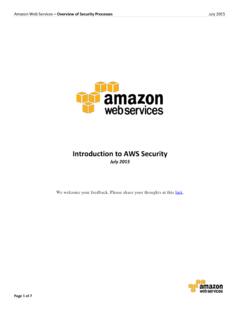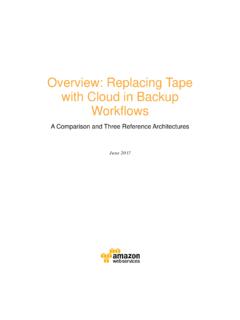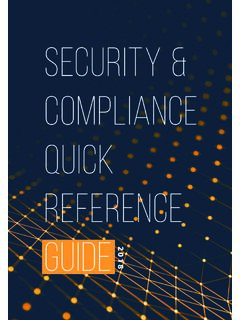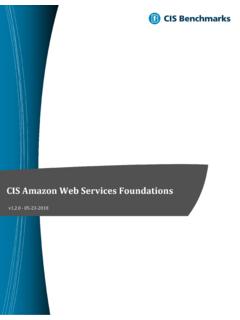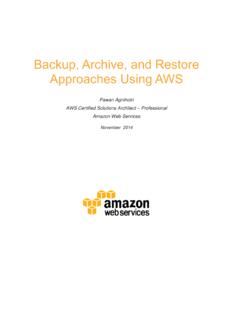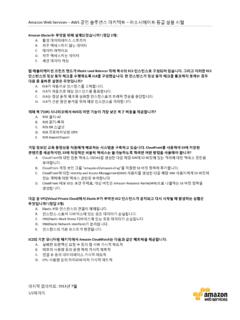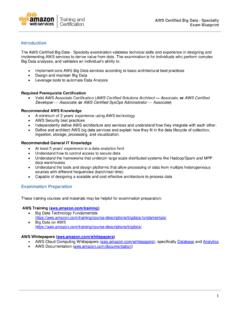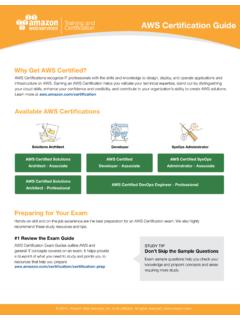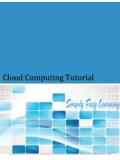Transcription of An Overview of the AWS Cloud Adoption Framework
1 An Overview of the AWS Cloud Adoption Framework Version 2 February 2017 2017, Amazon Web Services, Inc. or its affiliates. All rights reserved. Notices This document is provided for informational purposes only. It represents AWS s current product offerings and practices as of the date of issue of this document, which are subject to change without notice. Customers are responsible for making their own independent assessment of the information in this document and any use of AWS s products or services, each of which is provided as is without warranty of any kind, whether express or implied. This document does not create any warranties, representations, contractual commitments, conditions or assurances from AWS, its affiliates, suppliers or licensors. The responsibilities and liabilities of AWS to its customers are controlled by AWS agreements, and this document is not part of, nor does it modify, any agreement between AWS and its customers.
2 Contents Introduction 1 Mapping the Journey to the Cloud 4 AWS CAF Perspectives: Additional Detail 5 Business Perspective: Value Realization 5 People Perspective: Roles and Readiness 7 Governance Perspective: Prioritization and Control 9 Platform Perspective: Applications and Infrastructure 11 Security Perspective: Risk and Compliance 13 Operations Perspective: Manage and Scale 14 Conclusion 17 Appendix 1: Changes from AWS CAF Version 1 18 Abstract Adopting Amazon Web Services (AWS) presents many benefits, such as increased business agility and flexibility, as well as reduced costs. However, in order to fully realize these benefits your staff may need to acquire new skills and create or update core processes. Doing so can maximize the business value and minimize the business risks of Cloud Adoption . The AWS Cloud Adoption Framework (AWS CAF) helps organizations understand how Cloud Adoption transforms the way they work, and it provides structure to identify and address gaps in skills and processes.
3 Applying the AWS CAF in your organization results in an actionable plan with defined work streams that can guide your organization s path to Cloud Adoption . This Framework leverages our experiences and best practices in assisting organizations around the world with their Cloud Adoption journey. Amazon Web Services An Overview of the AWS Cloud Adoption Framework Page 1 Introduction Cloud computing introduces a significant shift in how technology is obtained, used, and managed. It also shifts how organizations budget and pay for technology services. Cloud computing benefits organizations by giving them the ability to trade capital expense for variable expense, gain advantage from massive economies of scale, make agile capacity decisions, increase business speed and agility, stop spending money running and maintaining data centers, and go global in minutes. With Amazon Web Services (AWS) your organization can immediately provision the compute, storage, network, and database resources needed for any project.
4 These resources launch and are ready for use by your project team within minutes. The environment can be reconfigured easily, updated quickly, scaled up or down automatically to meet usage patterns and optimize spending, or shut down temporarily or permanently. The billing for AWS services becomes an operational expense rather than a capital expense. Cloud Adoption requires that fundamental changes are discussed and considered across the entire organization, and that stakeholders across all organizational units both outside and within IT support these changes. The AWS Cloud Adoption Framework (AWS CAF) provides guidance that supports each unit in your organization so that each area understands how to update skills, adapt existing processes, and introduce new processes to take maximum advantage of the services provided by Cloud computing . Thousands of organizations around the world have successfully migrated their businesses to the Cloud , relying on the AWS CAF to guide their efforts.
5 AWS and our partners provide tools and services that can help you every step of the way to ensure complete understanding and transition. At the highest level, the AWS CAF organizes guidance into six focus areas. We describe these focus areas as Perspectives. Figure 1 shows the six Perspectives of the AWS CAF. Amazon Web Services An Overview of the AWS Cloud Adoption Framework Page 2 Figure 1: The AWS Cloud Adoption Framework (CAF) Each AWS CAF Perspective is made up of a set of CAF Capabilities, which is a composite of responsibilities typically owned or managed by one or more functionally related stakeholders. Each Capability describes what a stakeholder owns or manages in the Cloud Adoption journey. The Capabilities are a standard used within the CAF. Each Capability consists of a set of CAF Skills and Processes that provide structure to identify gaps in your existing skills and processes. For example, the People Perspective provides guidance for stakeholders who own or manage human resources (HR), staffing functions, and people management responsibilities.
6 The guidance in this Perspective focuses on people development, training, and communications to assess how stakeholder-owned or -managed capabilities will transform with Cloud Adoption . In general, the Business, People, and Governance Perspectives focus on business capabilities, and the Platform, Security, and Operations Perspectives focus on technical capabilities. A brief description of each AWS CAF Perspective is provided here, with more detailed descriptions later in this whitepaper. Business Perspective Common roles: Business Managers, Finance Managers, Budget Owners, and Strategy Stakeholders. Helps stakeholders understand how to update the staff skills and organizational processes they will need to optimize business value as they move their operations to the Cloud . People Perspective Common roles: Human Resources, Staffing, and People Managers. Provides guidance for stakeholders responsible for people development, training, and communications.
7 Helps stakeholders understand how to Amazon Web Services An Overview of the AWS Cloud Adoption Framework Page 3 update the staff skills and organizational processes they will use to optimize and maintain their workforce, and ensure competencies are in place at the appropriate time. Governance Perspective Common roles: CIO, Program Managers, Project Managers, Enterprise Architects, Business Analysts, and Portfolio Managers. Provides guidance for stakeholders responsible for supporting business processes with technology. Helps stakeholders understand how to update the staff skills and organizational processes that are necessary to ensure business governance in the Cloud , and manage and measure Cloud investments to evaluate their business outcomes. Platform Perspective Common roles: CTO, IT Managers, and Solution Architects. Helps stakeholders understand how to update the staff skills and organizational processes that are necessary to deliver and optimize Cloud solutions and services.
8 Security Perspective Common roles: CISO, IT Security Managers, and IT Security Analysts. Helps stakeholders understand how to update the staff skills and organizational processes that are necessary to ensure that the architecture deployed in the Cloud aligns to the organization s security control requirements, resiliency, and compliance requirements. Operations Perspective Common roles: IT Operations Managers and IT Support Managers. Helps stakeholders understand how to update the staff skills and organizational processes that are necessary to ensure system health and reliability during the move of operations to the Cloud and then to operate using agile, ongoing, Cloud computing best practices. By identifying the gaps in skills and processes between the current IT environment and the future Cloud environment an organization can create an action plan designed to close these gaps. The AWS CAF Perspectives, Capabilities, Skills, and Processes are designed for organizations to use as they develop plans and work streams to move from their current IT environment to Amazon Web Services An Overview of the AWS Cloud Adoption Framework Page 4 the AWS Cloud , or to deploy a new environment in the AWS Cloud .
9 Stakeholders with organizational buy-in who apply the AWS CAF structure can create an actionable plan that helps the organization quickly and effectively achieve their desired Cloud Adoption . Mapping the Journey to the Cloud Each organization s Cloud Adoption journey is unique. In order to successfully execute your Adoption , you need to understand your organization s current state, the target state, and the transition required to achieve the target state. Knowing this will help you set goals and create work streams that will enable staff to thrive in the Cloud . Engaging stakeholders with their relevant AWS CAF Perspective helps inform your journey to Cloud Adoption . Through this discovery phase, you will explore capability gaps in terms of AWS CAF Skills and Processes, define necessary work streams, and identify interdependencies between work streams. Knowing work stream dependencies enables you to optimize collaboration on AWS. The AWS CAF provides the structure to discover what organizational skills you need to update and how to modify existing processes and introduce new ones.
10 Work streams are iterative and change over time. In some technology areas, you may find that it is best for work steams to be integrated with one another. Consider DevOps, for example. DevOps refers to practices, skills, and processes that depend on the collaboration of both development and operational teams. By collaborating across teams, you can automate the process of software delivery and infrastructure changes, which makes your organization more agile and efficient. With the AWS CAF, you re able to identify how technology development and operations teams can become more closely integrated, and by doing so, optimize business results in your Cloud environment. In a transition to the Cloud , stakeholders within each AWS CAF Perspective need to engage and actively own organizational and operational change for their area. As you implement work streams, your organization can leverage the different AWS CAF Perspectives to understand how to communicate interdependencies between different stakeholders.
